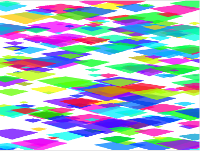Generative Art
Generative art refers to art that is created by a system that operates autonomously. The artist may create the system, and/or set some parameters that affect the outcome, but the result is created, at least in part, by the system rather than directly by the artist. Generative art systems are frequently computer programs, although biological, social, or other systems may also be used to generate art.
 |
 |
Similarly, generative music refers to music produced by a system, which could be a computer program. The composer creates the system that generates the music.
An important characteristic of generative art works and music is the surprise we encounter while making them. That is, you never know precisely what will happen. Intriguingly, since the outcome of a generative art or music system is not fully predetermined, variations are expected and surprising! You can think of this like a good conversation—you don’t know exactly what your partner is going to say, and the serendipity of the exchange is an important reason for having the conversation in the first place. Similarly, you don’t know (precisely) what you’re going to get from a generative art experience. This emergent serendipity is one of the most wonderful things about making generative art.
 |
 |
Software
Scratch is a programming language and online community where you can create your own interactive stories, games, and animations -- and share your creations with others around the world.
Turtle Art is a blocks programming environment for creating drawings and for explorations at the intersection of art, mathematics, and programming
TurtleArt app
TurtleArt reference guide
ArtLogo (a text-based equivalent of TurtleArt)
ArtLogo help
Resources
Scratch Studio for the Generating Surprising Art Through Coding workshop at ISTE 2019: https://scratch.mit.edu/studios/10268035/Scratch Studio for the generative art workshop at the 2018 MIT Scratch Conference: https://scratch.mit.edu/studios/5207280/
Scratch Studio for a similar workshop at the 2016 MIT Scratch Conference: https://scratch.mit.edu/studios/2941611/
Scratch Studio for generative art created in the Families Learning Together project at Texas State University in San Marcos: https://scratch.mit.edu/studios/4326022/
Scratch Studio for the Generating Surprising Art and Music with Scratch workshop at ISTE Live21: https://scratch.mit.edu/studios/29782566/
Articles about Generative Art
Wikipedia
article on Generative Art
What is Generative Art? by Phillip Galanter
Generative Art for
All by Michael Tempel
Articles about Generative Music
Introduction to Generative Music
How
Generative Music Works
Brian Eno on Music that Thinks for Itself
Fifty Years Of Steve Reich's 'It's Gonna Rain'
JavaScript Music Systems - a guide to creating
generative music
Web-based Generative Art tools
Interactive web
drawing
Chromata
Examples of Generative Art (computational)
Echophon (a collection on tumblr) Kyle
Stewart
Sean Justice, Five
Lines Option & Seven
Lines
The Game of Life - Emergence In Generative Art
is an exhibition that is a tribute to John Conway. Here is an essay that accompanies the
exhibition.
Vera Molnár's
website
Vera Molnár’s Artwork revisited using Python
Note: a Google search on “generative art” will return thousands
of examples!
Artists who might be considered exemplars, or pioneers of Generative Art (non- or per-computational)
Hans
Haacke
John
Cage
Ellsworth
Kelly
Sol
LeWitt
William
Burroughs
Other Resources
Generative
Art, a practical guide using Processing (Processing is a java based programming
language often used by artists and designers)
P5.js is a
friendly tool for learning to code and make art.
Society
for Generative Art